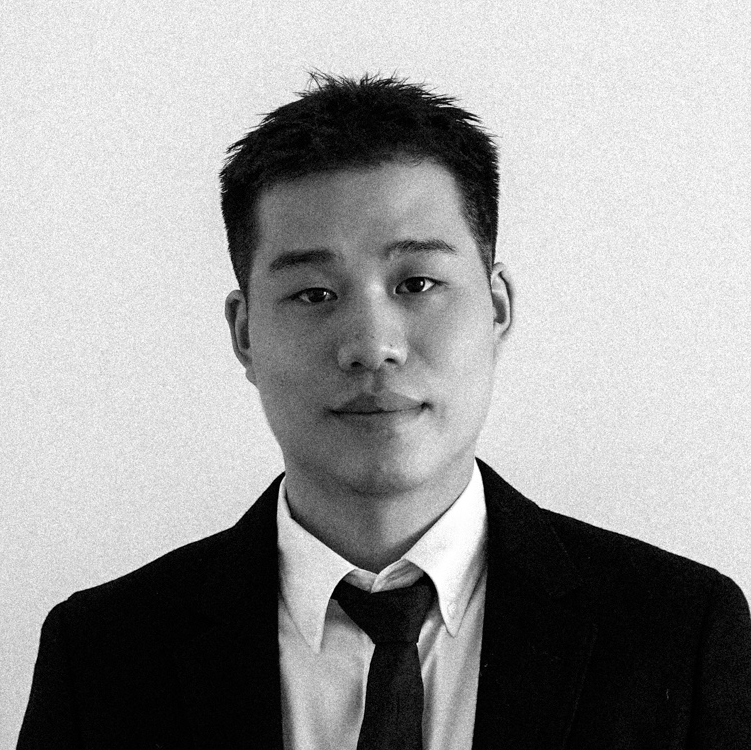The ASA Experimental Design Competition 2024, supervised by Ken Chongsuwat and Thomas Lozada, encouraged participants to expand on the foundational senses of sight, hearing, touch, smell, and taste, and incorporating a “Sixth Sense” with a distinct Thai flavor.

ASA Experimental Design Competition 2024 Sensing Architecture สัมผัส สถาปัตยกรรม และความรู้สึก
‘Collective Language : สัมผัส สถาปัตย์’ แนวความคิดหลักของงานสถาปนิก’67 สู่การเป็นโจทย์สำคัญที่ท้าทายนักเรียน นักศึกษา สถาปนิก และนักคิดจากทั่วทุกมุมโลก ให้เข้ามานำเสนอแนวทางของความคิดสร้างสรรค์และงานออกแบบ โดยใช้กรณีศึกษาของ ‘กรุงเทพมหานคร’ เพื่อสร้างความรู้สึกระหว่างผู้คนกับตัวเมืองผ่านประสาทสัมผัส
เคน จงสุวัฒน์ Adjunct Lecturer จาก International Program in Design and Architecture (INDA) จุฬาลงกรณ์มหาวิทยาลัย และ Design Director แห่ง A-Seven Corp. เล่าถึงกิจกรรมการประกวดแบบ ASA Experimental Design Competition 2024 ที่ชวนทุกคนมาร่วมสำรวจและค้นหาวิธีการสร้างสรรค์ที่ตอบสนอง ‘ความรู้สึก’ ในสังคมเมืองปัจจุบัน ผ่านหัวข้อ Sensing Architecture: Architecture Beyond Vision – สัมผัส สถาปัตยกรรม และความรู้สึก
“เราเริ่มต้นจากการทำความเข้าใจคอนเซปต์ของ Collective Language ว่าจะสามารถแปลงเป็นการประกวดแบบได้อย่างไรบ้าง เราจึงทำการเวิร์คชอปเพื่อค้นหาวิธีการสื่อสารที่ไร้ขอบเขตของภาษา จนมาลงตัวในเรื่องการสัมผัส เพราะไม่ว่าจะเราไปชมงานสถาปัตยกรรมในประเทศใด ๆ ก็ตาม เราสามารถที่จะเข้าใจสเปซได้โดยไม่ต้องมีภาษาหรือมีคนมาอธิบาย เราจึงตีความจากตรงนั้นว่า การสัมผัสสเปซแล้วสุดท้ายมันคืออะไร”
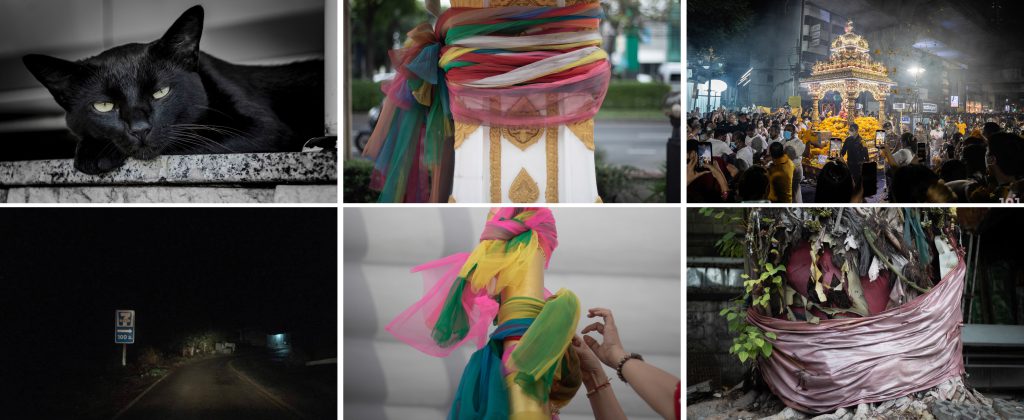
สัมผัสทั้ง 5 + สัมผัสที่ 6
ประสาทสัมผัสทั้ง 5 เป็นการนิยามการสัมผัสแบบเบื้องต้นอย่างง่ายที่สุดอย่างที่ทุกคนเข้าใจ แต่การประกวดครั้งนี้เพิ่มประสาทสัมผัสที่ 6 หรือ Sixth Sense เข้าไปด้วย ไม่เพียงแต่ให้โจทย์มีความท้าทายขึ้นเท่านั้น แต่ยังเจือกลิ่นอายความเป็นไทยท้องถิ่นในงานสถาปนิก’67 ที่มีประเทศไทยเป็นเจ้าภาพ “เราเริ่มตีความจาก 5 เซนส์ ก็คือการสัมผัส อย่างเรื่องสัมผัสในการเคาะจับวัสดุ เสียงในสเปซ งานดีไซน์ที่ใช้สายตามองเห็นเป็นหลัก เรื่องกลิ่นที่อาจจะเป็นกลิ่นถนนหรือสตรีทฟู้ด และเรื่องรสที่อาจจะยากที่สุดสำหรับงานสถาปัตยกรรม เลยไปต่อกับเรื่องประสาทสัมผัสทั้ง 5”
“แล้วพอเป็นงานสถาปนิกที่จัดในเมืองไทย ถึงแม้จะเป็นการสื่อสารในระดับนานาชาติแล้ว แต่เราก็อยากดึงเอาเรื่องความเชื่อหรือพื้นที่ศักดิ์สิทธิ์ ซึ่งหลายครั้งก็เปลี่ยนความรู้สึกระหว่างคนกับงานสถาปัตยกรรมได้ จึงมองว่าเรื่องนี้น่าสนใจและเข้ากับงาน Experimental เช่นกัน เลยเอามาตั้งเป็นโจทย์ที่ท้าทายขึ้นอีก”
เพราะมี ‘กรุงเทพมหานคร’ เป็นกรณีศึกษาหลัก จึงอาจตีความได้ถึงความเป็นเมืองที่ต้องพึ่งพาเทคโนโลยีในทุกวันแล้ว จากเรื่องนี้จะส่งผลกระทบต่อการใช้ชีวิตของผู้คนอย่างไร เซนส์เรื่องสัมผัสของการพบปะซึ่งหน้าอาจลดลง แต่เซนส์เรื่องสายตากับเสียงอาจจะเพิ่มขึ้นจากการต้องใช้หน้าจอ ในขณะเดียวกัน เซนส์ด้านความเชื่อก็ยังเป็นที่พึ่งด้านจิตใจให้กับผู้คนในภาวะสังคมที่ซบเซา
ความรู้สึกระดับนานาชาติในกลิ่นอายแบบไทย
ความน่าสนใจของงานประกวดแบบ ASA Experimental Design Competition 2024 อีกประการในปีนี้ คือความเป็นสากล ทั้งคณะกรรมการผู้ตัดสิน และผู้เข้าประกวดที่มาจาก 17 ประเทศทั่วโลก โดยมีผู้ได้รับรางวัลส่วนหนึ่งเป็นชาวต่างชาติ
“ตอนที่เราเซ็ตทีมกรรมการ มีทั้งหมด 4 ท่านจากแบคกราวด์ที่แตกต่างกัน ซึ่งเราตั้งใจให้เป็นแบบนั้น ได้แก่ Daiji Chikuba จาก Nikken Sekkei บริษัทคอร์ปอเรตขนาดใหญ่ของญี่ปุ่นที่มีชื่อเสียงและแข็งแรงในเรื่องสถาปัตยกรรม, Kas Oosterhuis & Ilona Lénárd จาก ONL เนเธอร์แลนด์ สถาปนิกและศิลปินระดับตำนานในงานออกแบบสายทดลอง และ ผศ.ดร.สุพิชชา โตวิวิชญ์ อาจารย์ประจำคณะสถาปัตยกรรมศาสตร์ มหาวิทยาลัยศิลปากร ที่เข้าใจบริบทโลคอลไทยมาเป็นผู้เชื่อมประสานทีมกรรมการจากแต่ละฟากโลกเข้าด้วยกัน”
ในส่วนของประเภทผู้เข้าประกวด แบ่งเป็นประเภทบุคคลทั่วไปและประเภทนักเรียน/นักศึกษา ซึ่งความพิเศษในปีนี้คือการเติบโตขึ้นของเวทีในระดับนานาชาติ
“บางทีมก็ตีโจทย์ได้ดีในเรื่องของเซนส์ อาจจะไม่ได้มีการออกแบบเป็นสถาปัตยกรรม แต่เป็นการตีความสัมผัสในรูปแบบ Mapping กราฟิก หรือในส่วนของทีมเอง ที่แม้กระทั่งในประเภทบุคคลทั่วไป ก็เป็นนักออกแบบรุ่นใหม่ซึ่งเป็นวัยที่ยังมีพลังค่อนข้างเยอะก็ถือว่าเป็นการแข่งขันที่น่าสนใจ”
เคนยกตัวอย่างงานที่น่าสนใจ จากผู้ชนะเลิศในการแข่งขันทั้งสองประเภท เริ่มจากประเภทนักเรียน/นักศึกษา คือผลงาน Die to Grow Memorial Park โดยเบญญาพร วิเชียรสรรค์และณัฏฐณิชา สถานานนท์
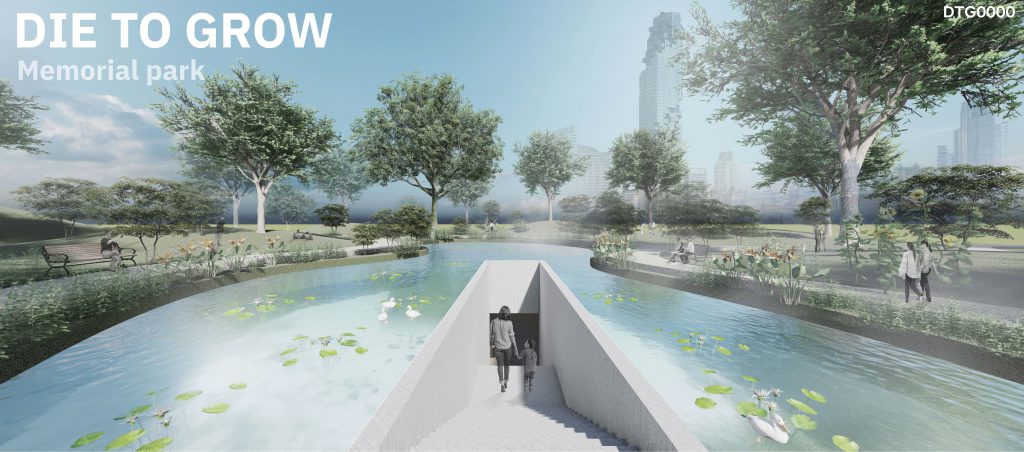
“งานนี้ได้ใจกรรมการในเรื่องของพื้นที่ซึ่งเป็นการขุดลงไปใต้ดินให้เห็นตัวรากของต้นไม้ และแนวคิดของงานที่เปรียบพื้นที่เหมือนกับวงจรชีวิต คือการเกิดและการตาย หากคนรักของเราเสียชีวิตไป ก็จะนำเถ้าอัฐิมาใส่ไว้เพื่อเป็นปุ๋ยให้กับต้นไม้ตามชื่องาน เลยมองว่ามันพูดเรื่องเซนส์ได้ดี อาจจะไปจนถึงเรื่องซิกส์เซนส์ก็ได้นะ เพราะความเชื่อต่าง ๆ สามารถนำมาดัดแปลงเป็นสเปซที่คนสามารถสัมผัส มองเห็น หรือรับรู้ถึงอากาศของใต้ดินที่เย็นกว่าข้างนอก เรียกว่าเป็นงานที่ตีโจทย์และแปลความออกมาเป็นสเปซได้ดี”
ส่วนอีกงานหนึ่งในประเภทบุคคลทั่วไป เป็นของ Shuang Chen จากสหรัฐอเมริกา ในชื่อว่า Lantern: A Multi-Sensory Dining Experience
“งานนี้เล่นกับเรื่องอาหาร เพราะพอพูดถึงอาหารปุ๊บก็มีเซนส์ทั้ง 5 เข้ามาครบเลย และเขาดัดแปลงออกมาเป็นสเปซได้ค่อนข้างดี โดยแต่ละโซนจะมีสเปซที่แตกต่างที่รู้สึกถึงเซนส์ที่ต่างกัน ตรงนี้เลยมองถึงการตีโจทย์และกราฟิกของการสื่อสารคอนเซปต์ได้ตรงไปตรงมาและเข้าใจได้ดี”

อนาคตของการประกวดแบบบนเวทีไร้พรมแดน
“งานประกวดแบบในปีนี้เราพยายามจะสื่อสารให้เห็นว่าโลกมันเล็กลง ให้เห็นว่าทุกคนสามารถมีส่วนร่วมได้ และโลกก็เชื่อมถึงกันมากขึ้น” เคนเล่าจากภาพรวมของงานประกวดในปีนี้ ที่ครึ่งหนึ่งของผู้ได้รับรางวัลเป็นชาวต่างชาติ ทั้งในภูมิภาคเอเชียตะวันออกเฉียงใต้เองและต่างประเทศ
“ผมมองว่าเป็นการเริ่มต้นที่ดีครับ เพราะที่ผ่านมาเรามักจะเห็นคนชนะและได้รับรางวัลเป็นคนไทย แต่ตอนนี้เวทีที่ยกระดับขึ้นไปสู้กับเพื่อนบ้านหรือนานาชาติในอีกซีกโลกหนึ่ง ก็นับเป็นนิมิตหมายที่ดีให้กับการแข่งขันในด้านความคิดสร้างสรรค์ และงานประกวดแบบนี้มันก็ช่วยเสริมเรื่องความมั่นใจในทักษะต่าง ๆ ให้กับเด็กรุ่นใหม่ไม่กลัวที่จะส่งงานประกวด และเป็นการกระตุ้นให้เห็นว่าเมื่อมีโอกาสแล้วก็ควรลองดู”
อีกส่วนหนึ่งที่เคนให้ทรรศนะอย่างน่าสนใจจากภาพรวมของการประกวดแบบในปีนี้ เป็นเรื่องการนำเสนองานโดยใช้ AI-Generated เข้ามาร่วม ซึ่งถ้าจะนับจริง ๆ แล้ว ในช่วงนี้ก็ยังเป็นช่วงทับซ้อน ยังไม่เห็นภาพที่ชัดเจนนัก แต่แน่นอนว่า AI คืออนาคตที่กำลังเดินทางมาถึง นี่ก็เป็นอีกบทเรียนหนึ่งสำหรับกรรมการเช่นเดียวกัน
“เราในฐานะผู้จัดและทีมกรรมการเองก็ได้เรียนรู้ถึงการวางขอบเขตของกฎกติกา หรือการตัดสินสำหรับการแข่งขันในครั้งต่อ ๆ ไป เพราะในอนาคตต้องมีงานที่ใช้ AI มากขึ้นเรื่อย ๆ อย่างแน่นอน อย่างการใช้ AI เป็นเครื่องมือในการเล่าเรื่องราวหรือบอกเล่าความคิดก็ควรจะทำได้หรือไม่อย่างไร ก็ยังเป็นเรื่องที่ถกเถียงกันอยู่”
เคนทิ้งท้ายว่า “ผมมองว่างานประกวดแบบเหมือนเป็นปรอท ผู้แข่งขันเองสามารถปรับตัวเองในเวทีโลกได้หรือไม่ แล้วชุดความคิดของนักออกแบบรุ่นใหม่อยู่ตรงไหนของเวทีโลก การแข่งขันก็อาจมีชนะบ้างแพ้บ้าง แต่ก็ทำให้เห็นว่าไอเดียความคิดของเราอยู่ในระดับไหนหรือสามารถสู้กับเวทีนานาชาติได้ไหม ผู้เข้าประกวดก็จะได้รับประสบการณ์ตรงนั้นด้วยอย่างแน่นอน”
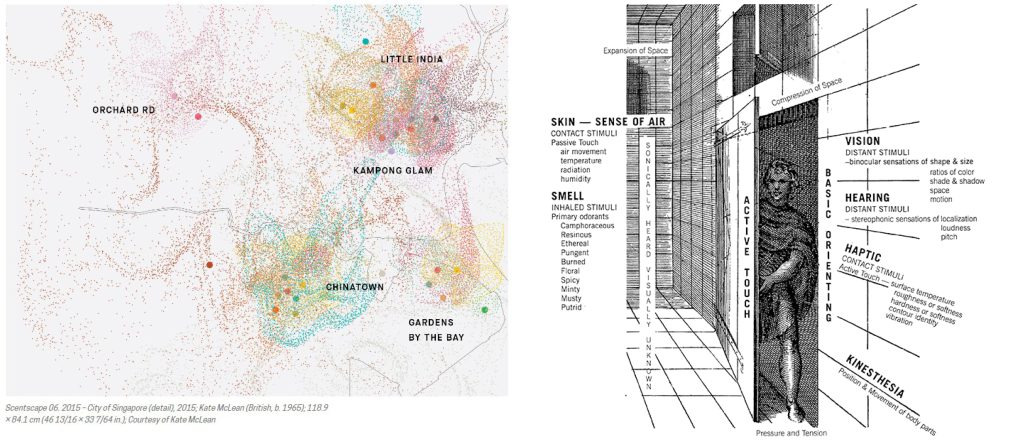
The cornerstone theme of Architect Expo 2024, “Collective Language” invites students, architects, and thinkers worldwide to share their innovative visions by utilizing Bangkok as a focal case study. This initiative aims to establish a sensory connection between the cityscape and its inhabitants.
Ken Chongsuwat, who has dual responsibilities as Design Director at A-Seven Corp. and adjunct lecturer at Chulalongkorn University’s International Program in Design and Architecture (INDA), explores the intricacies of the ASA Experimental Design Competition 2024. The competition theme, “Sensing Architecture: Architecture Beyond Vision,” encourages participants to investigate innovative and inventive methods of engaging with the “feelings” of contemporary urban society.
“We began by understanding how the concept of Collective Language could be translated into a design competition,” according to Ken. “This resulted in a workshop that delved into the potential of limitless communication through sensory experiences. Architecture can be universally comprehended without language or explanations, regardless of geographical context. The query “What is the ultimate culmination of experiencing a space?” was the focal point of our interpretation.”
Sixth Sense + Five Senses
The rudimentary framework through which we all perceive space is formed by architecture’s foundational senses of sight, hearing, touch, smell, and taste. Nevertheless, the ASA Experimental Design Competition 2024 expands upon this framework by incorporating a “Sixth Sense,” which intensifies the challenge and incorporates a unique Thai flavor.
“We initiated the interpretation by utilizing the conventional five senses, from the tactile—the sensation of materials’ textures—to the auditory experiences within spaces, the visual predominance in design, the aromas of bustling streets or vibrant street food, and lastly, taste, which presents a distinctive challenge in architectural expression. These sensory engagements were subsequently expanded as a result of our voyage.”
“We endeavored to integrate elements of belief or sacrosanct spaces, which frequently alter the emotional connection between individuals and architecture even though this architectural event communicates internationally. This concept is engaging and appropriate for the event’s experimental nature, posing a more difficult question.”
The competition prompts reflections on a city profoundly intertwined with technology, with Bangkok as the focal case study. It explores how this reliance shapes human connections. As reliance on digital interfaces increases, visual and auditory engagements may be enhanced, potentially reducing the importance of physical interactions. However, traditional belief systems continue to exist in the face of this technological engulfment, offering a spiritual and emotional foundation in a subdued societal environment.
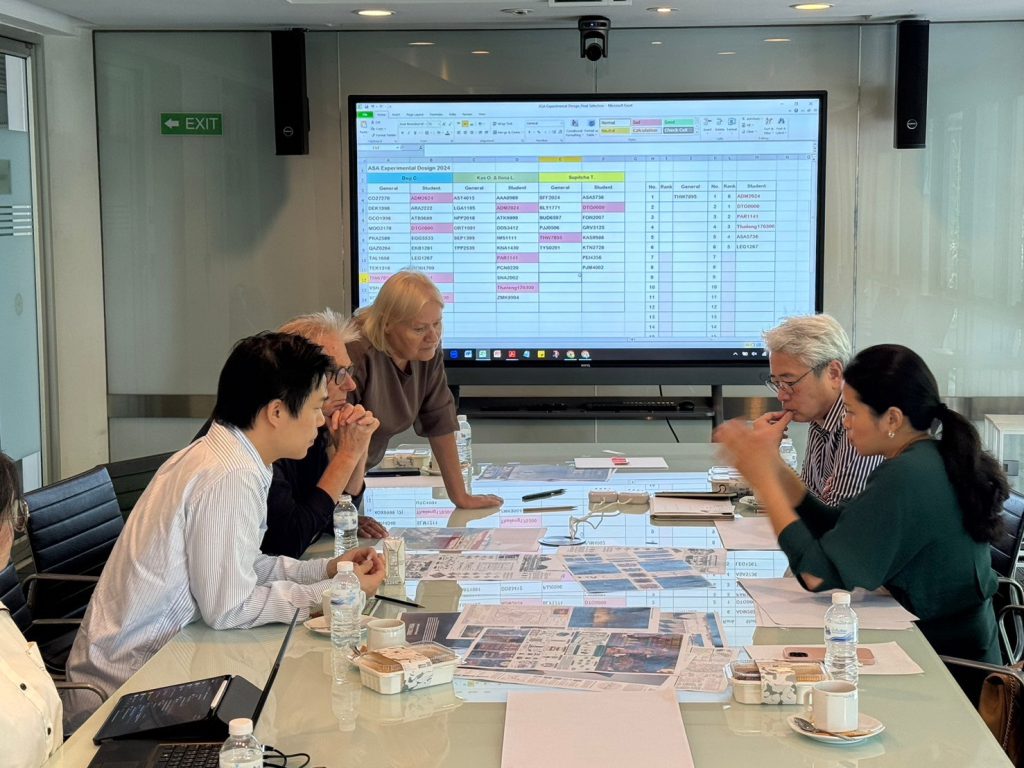
International Sensibilities with a Thai Twist
One of the ASA Experimental Design Competition 2024’s most captivating features is its international dimension. This year’s event features a diverse panel of judges and participants from 17 countries worldwide, and some of the winning proposals were submitted by international entrants. Ken Chongsuwat explains, “We were intentional in our selection of the judging panel, ensuring that it was representative of the community. “Our choices included Daiji Chikuba from Nikken Sekkei, a major Japanese architecture firm known for its corporate prowess; Dutch legends Kas Oosterhuis and Ilona Lénárd from ONL, who are renowned for their trailblazing in experimental design; and Assistant Professor Dr. Supitcha Tovivich from Silpakorn University’s Faculty of Architecture, who brings a nuanced understanding of the Thai milieu that is essential for synthesizing the international viewpoints of the judging panel.”
The competition is divided into two categories: the general category and the student category. This year’s entries are noteworthy for their emphasis on the competition’s broader international scope. “Some teams distinguished themselves by reimagining the sensory theme through graphic mappings of sensory experiences, rather than traditional architecture.” Contributions from youthful designers were particularly thrilling in the general category, as their energy and innovative viewpoints invigorated the competition.
Ken Chongsuwat emphasized several exceptional projects submitted by the victors of both competition categories, commencing with the student category. The judges were interested in the initiative “Die to Grow Memorial Park” by Benyaporn Wichianson and Nattanicha Stananon.
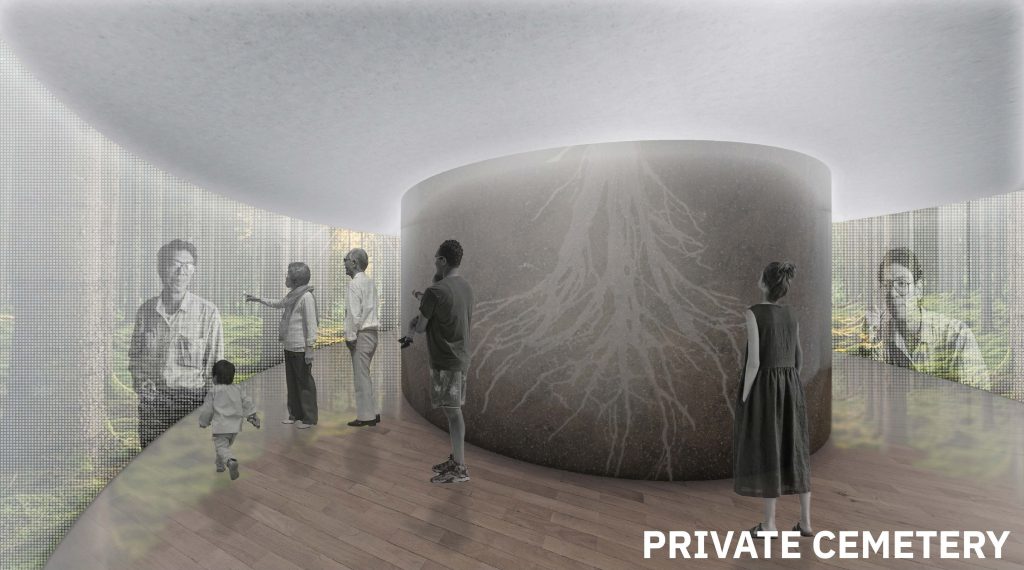
“This project captivated us with its inventive use of space, which involved excavating underground to reveal the roots of trees, and its concept, which likens the area to the life cycle of birth and death. The endeavor is named after utilizing the ashes of a deceased loved one as fertilizer for trees. It is a well-interpreted and spatially coherent design, and it speaks to the senses exceptionally well. It could even touch upon the Sixth Sense, as it considers how beliefs can transform into a space that allows one to feel, see, and experience the cooler underground air.”
Another initiative by Shuang Chen from the United States, “Lantern: A Multi-Sensory Dining Experience,” delves into the general category of food.
“Food immediately stimulates all five senses, and this project meticulously designs each zone to provide a distinctive sensory experience. This method ensures that the theme is executed clearly and comprehensively, as it directly and effectively communicates the concept.”

In the Future of Borderless Design Competitions
“This year’s competition demonstrates the shrinking of the world, demonstrating that global connectivity is increasing and that everyone can participate,” explains Ken Chongsuwat in a reflection on the event. Half of the winners were foreigners from Southeast Asia and beyond.
“I regard it as a positive beginning. In the past, these awards were primarily won by Thai nationals; however, our platform has now reached a global level of competition, which is an optimistic sign for promoting creativity. Additionally, this competition serves to fortify the younger generation’s self-assurance in their abilities, motivates them to submit their entries without hesitation, and emphasizes the significance of grasping opportunities.”
Ken highlights another significant development in this year’s competition: the utilization of AIgenerated presentations, representing a new epoch in the design competition. It is a phase of transition during which the integration of AI is still being defined. The inevitable expanded application of AI presents a new dimension for organizers and judges to consider.
“Both the organizer and the judging panel experience a learning curve. We acknowledge the importance of establishing the boundaries and judging criteria for AI’s participation in future competitions, as the role of AI in idea expression and narrative continues to be a topic of debate.”
“I compared this competition to a thermometer, evaluating the ability of contestants to adjust to the global stage and the international standing of the innovative ideas of new designers. Although competitors may emerge victorious or defeated, the experience provides participants with an invaluable understanding of their ideas’ global quality and ability to withstand international scrutiny.”
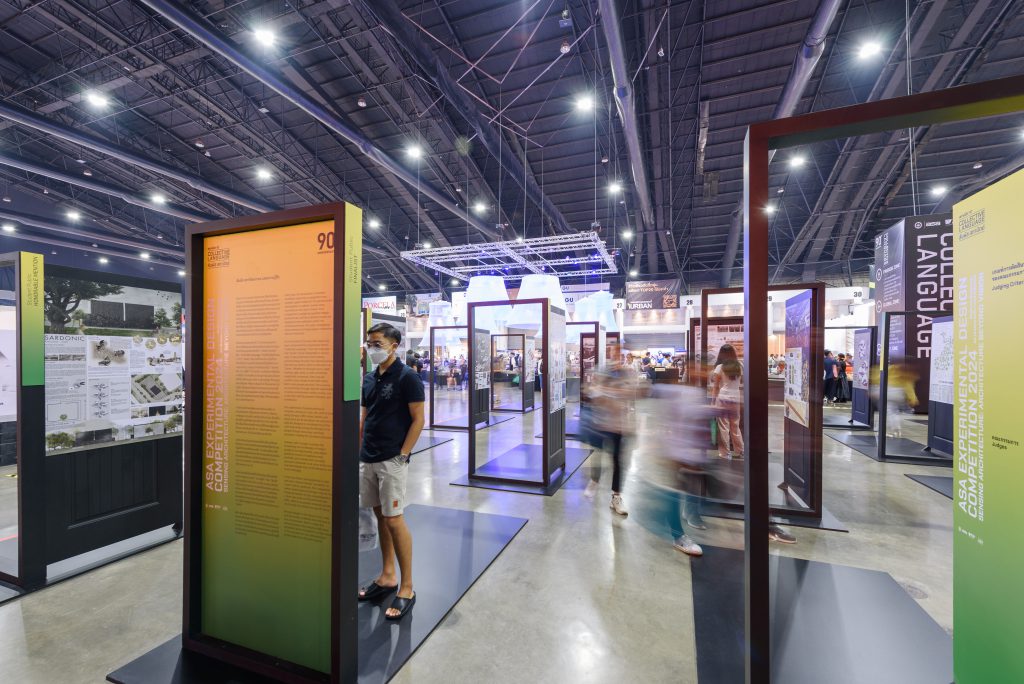
อ่านบทความคอลัมน์อื่นๆ หรือดาวน์โหลดเล่มวารสารฉบับออนไลน์ 18 Collective Language คลิกได้ที่นี่
อ่านบทความคอลัมน์อื่นๆ หรือดาวน์โหลดเล่มวารสารฉบับออนไลน์ Collective Language: EPILOGUE คลิกได้ที่นี่


